UAV Detection with Passive Radar: Algorithms, Applications, and Challenges
Abstract
1. Introduction
2. An Overview of Passive Radar
2.1. The Origins of Passive Radar
2.2. Signal Processing Workflow of Passive Radar
3. Choice of IOs for UAV Tracking in Passive Radar Systems
3.1. Types of IO for Passive Radar
3.2. UAV Detection with Various IOs
4. Signal Processing Methods for UAV Detection Using Passive Radar
4.1. Clutter Suppression Algorithms in Passive Radar System
4.2. Method of Estimating RD Map
4.3. Signal Processing for UAV Detection Using Passive Radar
5. Special Advance for UAVs Detection
6. Outlook and Challenge
7. Conclusions
Author Contributions
Funding
Data Availability Statement
Conflicts of Interest
References
- Shakhatreh, H.; Sawalmeh, A.H.; Al-Fuqaha, A.; Dou, Z.; Almaita, E.; Khalil, I.; Othman, N.S.; Khreishah, A.; Guizani, M. Unmanned Aerial Vehicles (UAVs): A Survey on Civil Applications and Key Research Challenges. IEEE Access 2019, 7, 48572–48634. [Google Scholar] [CrossRef]
- Hayat, S.; Yanmaz, E.; Muzaffar, R. Survey on Unmanned Aerial Vehicle Networks for Civil Applications: A Communications Viewpoint. IEEE Commun. Surv. Tutor. 2016, 18, 2624–2661. [Google Scholar] [CrossRef]
- Hugenholtz, C.H.; Whitehead, K.; Brown, O.W.; Barchyn, T.E.; Moorman, B.J.; LeClair, A.; Riddell, K.; Hamilton, T. Geomorphological mapping with a small unmanned aircraft system (sUAS): Feature detection and accuracy assessment of a photogrammetrically-derived digital terrain model. Geomorphology 2013, 194, 16–24. [Google Scholar] [CrossRef]
- Hossein Motlagh, N.; Taleb, T.; Arouk, O. Low-Altitude Unmanned Aerial Vehicles-Based Internet of Things Services: Comprehensive Survey and Future Perspectives. IEEE Internet Things J. 2016, 3, 899–922. [Google Scholar] [CrossRef]
- Mathur, P.; Nielsen, R.H.; Prasad, N.R.; Prasad, R. Data collection using miniature aerial vehicles in wireless sensor networks. IET Wirel. Sens. Syst. 2016, 6, 17–25. [Google Scholar] [CrossRef]
- Choi, H.W.; Kim, H.J.; Kim, S.K.; Na, W.S. An Overview of Drone Applications in the Construction Industry. Drones 2023, 7, 515. [Google Scholar] [CrossRef]
- Khan, M.A.; Menouar, H.; Eldeeb, A.; Abu-Dayya, A.; Salim, F.D. On the Detection of Unauthorized Drones—Techniques and Future Perspectives: A Review. IEEE Sens. J. 2022, 22, 11439–11455. [Google Scholar] [CrossRef]
- Kang, H.; Joung, J.; Kim, J.; Kang, J.; Cho, Y.S. Protect Your Sky: A Survey of Counter Unmanned Aerial Vehicle Systems. IEEE Access 2020, 8, 168671–168710. [Google Scholar] [CrossRef]
- Wang, J.; Liu, Y.; Song, H. Counter-Unmanned Aircraft System(s) (C-UAS): State of the Art, Challenges, and Future Trends. IEEE Aerosp. Electron. Syst. Mag. 2021, 36, 4–29. [Google Scholar] [CrossRef]
- Vilímek, J.; Buřita, L. Ways for copter drone acustic detection. In Proceedings of the 2017 International Conference on Military Technologies (ICMT), Brno, Czech Republic, 31 May–2 June 2017; pp. 349–353. [Google Scholar] [CrossRef]
- Chang, X.; Yang, C.; Wu, J.; Shi, X.; Shi, Z. A surveillance system for drone localization and tracking using acoustic arrays. In Proceedings of the 2018 IEEE 10th Sensor Array and Multichannel Signal Processing Workshop (SAM), Sheffield, UK, 8–11 July 2018; IEEE: Piscataway, NJ, USA, 2018; pp. 573–577. [Google Scholar]
- Kim, J.; Park, C.; Ahn, J.; Ko, Y.; Park, J.; Gallagher, J.C. Real-time UAV sound detection and analysis system. In Proceedings of the 2017 IEEE Sensors Applications Symposium (SAS), Glassboro, NJ, USA, 13–15 March 2017; pp. 1–5. [Google Scholar] [CrossRef]
- Jang, B.; Seo, Y.; On, B.; Im, S. Euclidean distance based algorithm for UAV acoustic detection. In Proceedings of the 2018 International Conference on Electronics, Information, and Communication (ICEIC), Honolulu, HI, USA, 24–27 January 2018; pp. 1–2. [Google Scholar] [CrossRef]
- Christnacher, F.; Hengy, S.; Laurenzis, M.; Matwyschuk, A.; Naz, P.; Schertzer, S.; Schmitt, G. Optical and acoustical UAV detection. In Proceedings of the Electro-Optical Remote Sensing X, Edinburgh, UK, 26–27 September 2016; SPIE: Bellingham, WA, USA, 2016; Volume 9988, pp. 83–95. [Google Scholar]
- Andraši, P.; Radišić, T.; Muštra, M.; Ivošević, J. Night-time detection of uavs using thermal infrared camera. Transp. Res. Procedia 2017, 28, 183–190. [Google Scholar] [CrossRef]
- Bisio, I.; Garibotto, C.; Lavagetto, F.; Sciarrone, A.; Zappatore, S. Unauthorized Amateur UAV Detection Based on WiFi Statistical Fingerprint Analysis. IEEE Commun. Mag. 2018, 56, 106–111. [Google Scholar] [CrossRef]
- Miquel, T.; Condomines, J.P.; Chemali, R.; Larrieu, N. Design of a robust controller/observer for TCP/AQM network: First application to intrusion detection systems for drone fleet. In Proceedings of the 2017 IEEE/RSJ International Conference on Intelligent Robots and Systems (IROS), Vancouver, BC, Canada, 24–27 September 2017; pp. 1707–1712. [Google Scholar] [CrossRef]
- Mototolea, D.; Stolk, C. Detection and localization of small drones using commercial off-the-shelf fpga based software defined radio systems. In Proceedings of the 2018 International Conference on Communications (COMM), Bucharest, Romania, 14–16 June 2018; IEEE: Piscataway, NJ, USA, 2018; pp. 465–470. [Google Scholar]
- Shin, D.H.; Jung, D.H.; Kim, D.C.; Ham, J.W.; Park, S.O. A Distributed FMCW Radar System Based on Fiber-Optic Links for Small Drone Detection. IEEE Trans. Instrum. Meas. 2017, 66, 340–347. [Google Scholar] [CrossRef]
- De Quevedo, A.D.; Urzaiz, F.I.n.; Menoyo, J.G.; López, A.A. Drone Detection with X-Band Ubiquitous Radar. In Proceedings of the 2018 19th International Radar Symposium (IRS), Bonn, Germany, 20–22 June 2018; pp. 1–10. [Google Scholar] [CrossRef]
- Samaras, S.; Diamantidou, E.; Ataloglou, D.; Sakellariou, N.; Vafeiadis, A.; Magoulianitis, V.; Lalas, A.; Dimou, A.; Zarpalas, D.; Votis, K.; et al. Deep Learning on Multi Sensor Data for Counter UAV Applications—A Systematic Review. Sensors 2019, 19, 4837. [Google Scholar] [CrossRef] [PubMed]
- Kuschel, H. Approaching 80 years of passive radar. In Proceedings of the 2013 International Conference on Radar, Adelaide, SA, Australia, 9–12 September 2013; pp. 213–217. [Google Scholar] [CrossRef]
- Griffiths, H. Early history of bistatic radar. In Proceedings of the 2016 European Radar Conference (EuRAD), London, UK, 5–7 October 2016; pp. 253–257. [Google Scholar]
- Howland, P. Target tracking using television-based bistatic radar. IEE Proc.-Radar Sonar Navig. 1999, 146, 166–174. [Google Scholar] [CrossRef]
- Griffiths, H.; Cohen, L.; Watts, S.; Mokole, E.; Baker, C.; Wicks, M.; Blunt, S. Radar Spectrum Engineering and Management: Technical and Regulatory Issues. Proc. IEEE 2015, 103, 85–102. [Google Scholar] [CrossRef]
- Colone, F.; Filippini, F.; Pastina, D. Passive Radar: Past, Present, and Future Challenges. IEEE Aerosp. Electron. Syst. Mag. 2023, 38, 54–69. [Google Scholar] [CrossRef]
- Griffiths, H.; Baker, C. Passive coherent location radar systems. Part 1: Performance prediction. IEE Proc.-Radar Sonar Navig. 2005, 152, 153–159. [Google Scholar] [CrossRef]
- Baker, C.; Griffiths, H.; Papoutsis, I. Passive coherent location radar systems. Part 2: Waveform properties. IEE Proc.-Radar Sonar Navig. 2005, 152, 160–168. [Google Scholar] [CrossRef]
- Farina, A.; Kuschel, H. Guest editorial special issue on passive radar (Part I). IEEE Aerosp. Electron. Syst. Mag. 2012, 27, 5-5. [Google Scholar] [CrossRef]
- Liu, F.; Cui, Y.; Masouros, C.; Xu, J.; Han, T.X.; Eldar, Y.C.; Buzzi, S. Integrated Sensing and Communications: Toward Dual-Functional Wireless Networks for 6G and Beyond. IEEE J. Sel. Areas Commun. 2022, 40, 1728–1767. [Google Scholar] [CrossRef]
- Zhao, Z.; Wan, X.; Zhang, D.; Cheng, F. An Experimental Study of HF Passive Bistatic Radar Via Hybrid Sky-Surface Wave Mode. IEEE Trans. Antennas Propag. 2013, 61, 415–424. [Google Scholar] [CrossRef]
- Gassier, G.; Chabriel, G.; Barrère, J.; Briolle, F.; Jauffret, C. A Unifying Approach for Disturbance Cancellation and Target Detection in Passive Radar Using OFDM. IEEE Trans. Signal Process. 2016, 64, 5959–5971. [Google Scholar] [CrossRef]
- Colone, F.; O’Hagan, D.W.; Lombardo, P.; Baker, C.J. A Multistage Processing Algorithm for Disturbance Removal and Target Detection in Passive Bistatic Radar. IEEE Trans. Aerosp. Electron. Syst. 2009, 45, 698–722. [Google Scholar] [CrossRef]
- Palmer, J.E.; Harms, H.A.; Searle, S.J.; Davis, L. DVB-T Passive Radar Signal Processing. IEEE Trans. Signal Process. 2013, 61, 2116–2126. [Google Scholar] [CrossRef]
- Chen, Z.; Yi, W.; Blum, R.S.; Kong, L.; Yang, X. Passive localization for emitter with unknown LFM signal based on signal parameter estimation. In Proceedings of the 2016 IEEE Radar Conference (RadarConf), Philadelphia, PA, USA, 2–6 May 2016; pp. 1–6. [Google Scholar] [CrossRef]
- Abratkiewicz, K.; Samczyński, P.; Mazurek, G.; Bartoszewski, M.; Julczyk, J. Passive Radar Using a Non-Cooperative Over-the-Horizon Radar as an Illuminator—First Results. In Proceedings of the 2024 IEEE Radar Conference (RadarConf24), Denver, CO, USA, 6–10 May 2024; pp. 1–6. [Google Scholar] [CrossRef]
- Colone, F.; Cardinali, R.; Lombardo, P. Cancellation of clutter and multipath in passive radar using a sequential approach. In Proceedings of the 2006 IEEE Conference on Radar, Verona, NY, USA, 24–27 April 2006; pp. 1–7. [Google Scholar] [CrossRef]
- Colone, F.; Bongioanni, C.; Lombardo, P. Multifrequency integration in FM radio-based passive bistatic radar. Part I: Target detection. IEEE Aerosp. Electron. Syst. Mag. 2013, 28, 28–39. [Google Scholar] [CrossRef]
- Colone, F.; Bongioanni, C.; Lombardo, P. Multifrequency integration in FM radio-based passive bistatic radar. Part II: Direction of arrival estimation. IEEE Aerosp. Electron. Syst. Mag. 2013, 28, 40–47. [Google Scholar] [CrossRef]
- Martelli, T.; Colone, F.; Tilli, E.; Di Lallo, A. Multi-Frequency Target Detection Techniques for DVB-T Based Passive Radar Sensors. Sensors 2016, 16, 1594. [Google Scholar] [CrossRef]
- Filippini, F.; Colone, F. Multi-carrier Adaptive Detection in Polarimetric Passive Radars. In Proceedings of the 2020 IEEE Radar Conference (RadarConf20), Florence, Italy, 21–25 September 2020; pp. 1–6. [Google Scholar] [CrossRef]
- Santi, F.; Pastina, D.; Bucciarelli, M. Experimental Demonstration of Ship Target Detection in GNSS-Based Passive Radar Combining Target Motion Compensation and Track-before-Detect Strategies. Sensors 2020, 20, 599. [Google Scholar] [CrossRef]
- Pisciottano, I.; Cristallini, D.; Pastina, D. Maritime target imaging via simultaneous DVB-T and DVB-S passive ISAR. IET Radar Sonar Navig. 2019, 13, 1479–1487. [Google Scholar] [CrossRef]
- Filippini, F.; Cabrera, O.; Bongioanni, C.; Colone, F.; Lombardo, P. DVB-S based Passive Radar for Short Range Security Application. In Proceedings of the 2021 IEEE Radar Conference (RadarConf21), Atlanta, GA, USA, 7–14 May 2021; pp. 1–6. [Google Scholar] [CrossRef]
- Blázquez-García, R.; Cristallini, D.; Ummenhofer, M.; Seidel, V.; Heckenbach, J.; O’Hagan, D. Experimental comparison of Starlink and OneWeb signals for passive radar. In Proceedings of the 2023 IEEE Radar Conference (RadarConf23), San Antonio, TX, USA, 1–5 May 2023; pp. 1–6. [Google Scholar] [CrossRef]
- Stove, A.G.; Gashinova, M.S.; Hristov, S.; Cherniakov, M. Passive Maritime Surveillance Using Satellite Communication Signals. IEEE Trans. Aerosp. Electron. Syst. 2017, 53, 2987–2997. [Google Scholar] [CrossRef]
- Daniel, L.; Hristov, S.; Lyu, X.; Stove, A.G.; Cherniakov, M.; Gashinova, M. Design and Validation of a Passive Radar Concept for Ship Detection Using Communication Satellite Signals. IEEE Trans. Aerosp. Electron. Syst. 2017, 53, 3115–3134. [Google Scholar] [CrossRef]
- Neinavaie, M.; Khalife, J.; Kassas, Z.M. Acquisition, Doppler Tracking, and Positioning with Starlink LEO Satellites: First Results. IEEE Trans. Aerosp. Electron. Syst. 2022, 58, 2606–2610. [Google Scholar] [CrossRef]
- Gomez-del Hoyo, P.; Samczynski, P. Starlink-Based Passive Radar for Earth’s Surface Imaging: First Experimental Results. IEEE J. Sel. Top. Appl. Earth Obs. Remote Sens. 2024, 17, 13949–13965. [Google Scholar] [CrossRef]
- Pastina, D.; Colone, F.; Martelli, T.; Falcone, P. Parasitic Exploitation of Wi-Fi Signals for Indoor Radar Surveillance. IEEE Trans. Veh. Technol. 2015, 64, 1401–1415. [Google Scholar] [CrossRef]
- Sun, H.; Chia, L.G.; Razul, S.G. Through-Wall Human Sensing with WiFi Passive Radar. IEEE Trans. Aerosp. Electron. Syst. 2021, 57, 2135–2148. [Google Scholar] [CrossRef]
- Pieraccini, M.; Miccinesi, L.; Rojhani, N. RCS measurements and ISAR images of small UAVs. IEEE Aerosp. Electron. Syst. Mag. 2017, 32, 28–32. [Google Scholar] [CrossRef]
- Solomitckii, D.; Gapeyenko, M.; Semkin, V.; Andreev, S.; Koucheryavy, Y. Technologies for Efficient Amateur Drone Detection in 5G Millimeter-Wave Cellular Infrastructure. IEEE Commun. Mag. 2018, 56, 43–50. [Google Scholar] [CrossRef]
- Ritchie, M.; Fioranelli, F.; Griffiths, H.; Torvik, B. Micro-drone RCS analysis. In Proceedings of the 2015 IEEE Radar Conference, Johannesburg, South Africa, 27–30 October 2015; pp. 452–456. [Google Scholar] [CrossRef]
- Martelli, T.; Murgia, F.; Colone, F.; Bongioanni, C.; Lombardo, P. Detection and 3D localization of ultralight aircrafts and drones with a WiFi-based passive radar. In Proceedings of the International Conference on Radar Systems (Radar 2017), Belfast, UK, 23–26 October 2017; pp. 1–6. [Google Scholar] [CrossRef]
- Chadwick, A.D. Micro-drone detection using software-defined 3G passive radar. In Proceedings of the International Conference on Radar Systems (Radar 2017), Belfast, UK, 23–26 October 2017; pp. 1–6. [Google Scholar] [CrossRef]
- Dan, Y.; Yi, J.; Wan, X.; Rao, Y.; Wang, B. LTE-based passive radar for drone detection and its experimental results. J. Eng. 2019, 2019, 6910–6913. [Google Scholar] [CrossRef]
- Knoedler, B.; Zemmari, R.; Koch, W. On the detection of small UAV using a GSM passive coherent location system. In Proceedings of the 2016 17th International Radar Symposium (IRS), Krakow, Poland, 10–12 May 2016; pp. 1–4. [Google Scholar] [CrossRef]
- Cabrera, O.; Bongioanni, C.; Filippini, F.; Sarabakha, O.; Colone, F.; Lombardo, P. Detecting drones and human beings with DVB-S based COTS passive radar for short-range surveillance. In Proceedings of the 2020 IEEE International Radar Conference (RADAR), Washington, DC, USA, 28–30 April 2020; pp. 37–42. [Google Scholar] [CrossRef]
- Ilioudis, C.V.; Cao, J.; Theodorou, I.; Striano, P.; Coventry, W.; Clemente, C.; Soraghan, J. GNSS Based Passive Radar for UAV Monitoring. In Proceedings of the 2019 IEEE Radar Conference (RadarConf), Boston, MA, USA, 22–26 April 2019; pp. 1–6. [Google Scholar] [CrossRef]
- Martelli, T.; Colone, F.; Cardinali, R. DVB-T based passive radar for simultaneous counter-drone operations and civil air traffic surveillance. IET Radar Sonar Navig. 2020, 14, 505–515. [Google Scholar] [CrossRef]
- Liu, Y.; Wan, X.; Tang, H.; Yi, J.; Cheng, Y.; Zhang, X. Digital television based passive bistatic radar system for drone detection. In Proceedings of the 2017 IEEE Radar Conference (RadarConf), Seattle, WA, USA, 8–12 May 2017; pp. 1493–1497. [Google Scholar] [CrossRef]
- Schüpbach, C.; Patry, C.; Maasdorp, F.; Böniger, U.; Wellig, P. Micro-UAV detection using DAB-based passive radar. In Proceedings of the 2017 IEEE Radar Conference (RadarConf), Seattle, WA, USA, 8–12 May 2017; pp. 1037–1040. [Google Scholar] [CrossRef]
- Colone, F.; Palmarini, C.; Martelli, T.; Tilli, E. Sliding extensive cancellation algorithm for disturbance removal in passive radar. IEEE Trans. Aerosp. Electron. Syst. 2016, 52, 1309–1326. [Google Scholar] [CrossRef]
- Yi, J.; Wan, X.; Li, D.; Leung, H. Robust Clutter Rejection in Passive Radar via Generalized Subband Cancellation. IEEE Trans. Aerosp. Electron. Syst. 2018, 54, 1931–1946. [Google Scholar] [CrossRef]
- Rabaste, O.; Poullin, D. Rejection of Doppler shifted multipaths in airborne passive radar. In Proceedings of the 2015 IEEE Radar Conference (RadarCon), Arlington, VA, USA, 10–15 May 2015; pp. 1660–1665. [Google Scholar] [CrossRef]
- Bosse, J.; Rabaste, O.; Poullin, D. Matching pursuit via continuous resolution cell rejection in presence of unresolved radar targets. In Proceedings of the 2015 23rd European Signal Processing Conference (EUSIPCO), Nice, France, 31 August–4 September 2015; pp. 1776–1780. [Google Scholar] [CrossRef]
- Bosse, J.; Rabaste, O. Subspace Rejection for Matching Pursuit in the Presence of Unresolved Targets. IEEE Trans. Signal Process. 2018, 66, 1997–2010. [Google Scholar] [CrossRef]
- Day, B.P.; Evers, A.; Hack, D.E. Multipath Suppression for Continuous Wave Radar via Slepian Sequences. IEEE Trans. Signal Process. 2020, 68, 548–557. [Google Scholar] [CrossRef]
- Zhao, Z.; Wan, X.; Shao, Q.; Gong, Z.; Cheng, F. Multipath clutter rejection for digital radio mondiale-based HF passive bistatic radar with OFDM waveform. IET Radar Sonar Navig. 2012, 6, 867–872. [Google Scholar] [CrossRef]
- Schwark, C.; Cristallini, D. Advanced multipath clutter cancellation in OFDM-based passive radar systems. In Proceedings of the 2016 IEEE Radar Conference (RadarConf), Philadelphia, PA, USA, 2–6 May 2016; pp. 1–4. [Google Scholar] [CrossRef]
- Searle, S.; Gustainis, D.; Hennessy, B.; Young, R. Cancelling strong Doppler shifted returns in OFDM based passive radar. In Proceedings of the 2018 IEEE Radar Conference (RadarConf18), Oklahoma City, OK, USA, 23–27 April 2018. pp. 0359–0354. [Google Scholar] [CrossRef]
- Searle, S.; Palmer, J.; Davis, L.; O’Hagan, D.W.; Ummenhofer, M. Evaluation of the ambiguity function for passive radar with OFDM transmissions. In Proceedings of the 2014 IEEE Radar Conference, Cincinnati, OH, USA, 19–23 May 2014; pp. 1040–1045. [Google Scholar] [CrossRef]
- Mercier, S.; Bidon, S.; Roque, D.; Enderli, C. Comparison of Correlation-Based OFDM Radar Receivers. IEEE Trans. Aerosp. Electron. Syst. 2020, 56, 4796–4813. [Google Scholar] [CrossRef]
- Rodriguez, J.T.; Colone, F.; Lombardo, P. Supervised Reciprocal Filter for OFDM Radar Signal Processing. IEEE Trans. Aerosp. Electron. Syst. 2023, 59, 3871–3889. [Google Scholar] [CrossRef]
- Quirini, A.; Colone, F.; Lombardo, P. Clutter Suppression Using Thresholded Reciprocal Filter in OFDM Radar. IEEE Trans. Aerosp. Electron. Syst. 2024, 60, 8316–8331. [Google Scholar] [CrossRef]
- Berger, C.R.; Demissie, B.; Heckenbach, J.; Willett, P.; Zhou, S. Signal Processing for Passive Radar Using OFDM Waveforms. IEEE J. Sel. Top. Signal Process. 2010, 4, 226–238. [Google Scholar] [CrossRef]
- Xie, R.; Hu, D.; Luo, K.; Jiang, T. Performance Analysis of Joint Range-Velocity Estimator with 2D-MUSIC in OFDM Radar. IEEE Trans. Signal Process. 2021, 69, 4787–4800. [Google Scholar] [CrossRef]
- Liu, Y.; Liao, G.; Chen, Y.; Xu, J.; Yin, Y. Super-Resolution Range and Velocity Estimations with OFDM Integrated Radar and Communications Waveform. IEEE Trans. Veh. Technol. 2020, 69, 11659–11672. [Google Scholar] [CrossRef]
- Zhang, F.; Zhang, Z.; Yu, W.; Truong, T.K. Joint Range and Velocity Estimation with Intrapulse and Intersubcarrier Doppler Effects for OFDM-Based RadCom Systems. IEEE Trans. Signal Process. 2020, 68, 662–675. [Google Scholar] [CrossRef]
- Werbunat, D.; Meinecke, B.; Schweizer, B.; Hasch, J.; Waldschmidt, C. OFDM-Based Radar Network Providing Phase Coherent DOA Estimation. IEEE Trans. Microw. Theory Tech. 2021, 69, 325–336. [Google Scholar] [CrossRef]
- Wu, X.; Kishk, A.; Glisson, A. MIMO-OFDM radar for direction estimation. IET Radar Sonar Navig. 2010, 4, 28–36. [Google Scholar] [CrossRef]
- Milani, I.; Bongioanni, C.; Colone, F.; Lombardo, P. Fusing Measurements from Wi-Fi Emission-Based and Passive Radar Sensors for Short-Range Surveillance. Remote Sens. 2021, 13, 3556. [Google Scholar] [CrossRef]
- Martelli, T.; Filippini, F.; Colone, F. Tackling the different target dynamics issues in counter drone operations using passive radar. In Proceedings of the 2020 IEEE International Radar Conference (RADAR), Washington, DC, USA, 28–30 April 2020; pp. 512–517. [Google Scholar] [CrossRef]
- Vorobev, E.; Veremyev, V.; Tulenkov, N. Experimental DVB-T2 Passive Radar Signatures of Small UAVs. In Proceedings of the 2019 Signal Processing Symposium (SPSympo), Krakow, Poland, 17–19 September 2019; pp. 67–70. [Google Scholar] [CrossRef]
- Jarabo-Amores, M.P.; Mata-Moya, D.; Gómez-del Hoyo, P.J.; Bárcena-Humanes, J.; Rosado-Sanz, J.; Rey-Maestre, N.; Rosa-Zurera, M. Drone detection feasibility with passive radars. In Proceedings of the 2018 15th European Radar Conference (EuRAD), Madrid, Spain, 26–28 September 2018; pp. 313–316. [Google Scholar] [CrossRef]
- Fang, G.; Yi, J.; Wan, X.; Liu, Y.; Ke, H. Experimental Research of Multistatic Passive Radar with a Single Antenna for Drone Detection. IEEE Access 2018, 6, 33542–33551. [Google Scholar] [CrossRef]
- Souli, N.; Kardaras, P.; Kolios, P.; Ellinas, G. Onboard Passive Radar System Implementation for Detection and Tracking of Rogue UAVs. In Proceedings of the 2023 International Conference on Unmanned Aircraft Systems (ICUAS), Warsaw, Poland, 6–9 June 2023; pp. 820–826. [Google Scholar] [CrossRef]
- Vinogradov, E.; Kovalev, D.A.; Pollin, S. Simulation and Detection Performance Evaluation of a UAV-mounted Passive Radar. In Proceedings of the 2018 IEEE 29th Annual International Symposium on Personal, Indoor and Mobile Radio Communications (PIMRC), Bologna, Italy, 9–12 September 2018; pp. 1185–1191. [Google Scholar] [CrossRef]
- Filippini, F.; Di Seglio, M.; Bongioanni, C.; Brennan, P.V.; Colone, F. OFDM based WiFi Passive Sensing: A reference-free non-coherent approach. In Proceedings of the 2023 IEEE Radar Conference (RadarConf23), San Antonio, TX, USA, 1–5 May 2023; pp. 1–6. [Google Scholar] [CrossRef]
- Colone, F.; Filippini, F.; Di Seglio, M.; Brennan, P.V.; Du, R.; Han, T.X. Reference-Free Amplitude-Based WiFi Passive Sensing. IEEE Trans. Aerosp. Electron. Syst. 2023, 59, 6432–6451. [Google Scholar] [CrossRef]
- Colone, F.; Filippini, F.; Di Seglio, M.; Chetty, K. On the Use of Reciprocal Filter Against WiFi Packets for Passive Radar. IEEE Trans. Aerosp. Electron. Syst. 2022, 58, 2746–2761. [Google Scholar] [CrossRef]


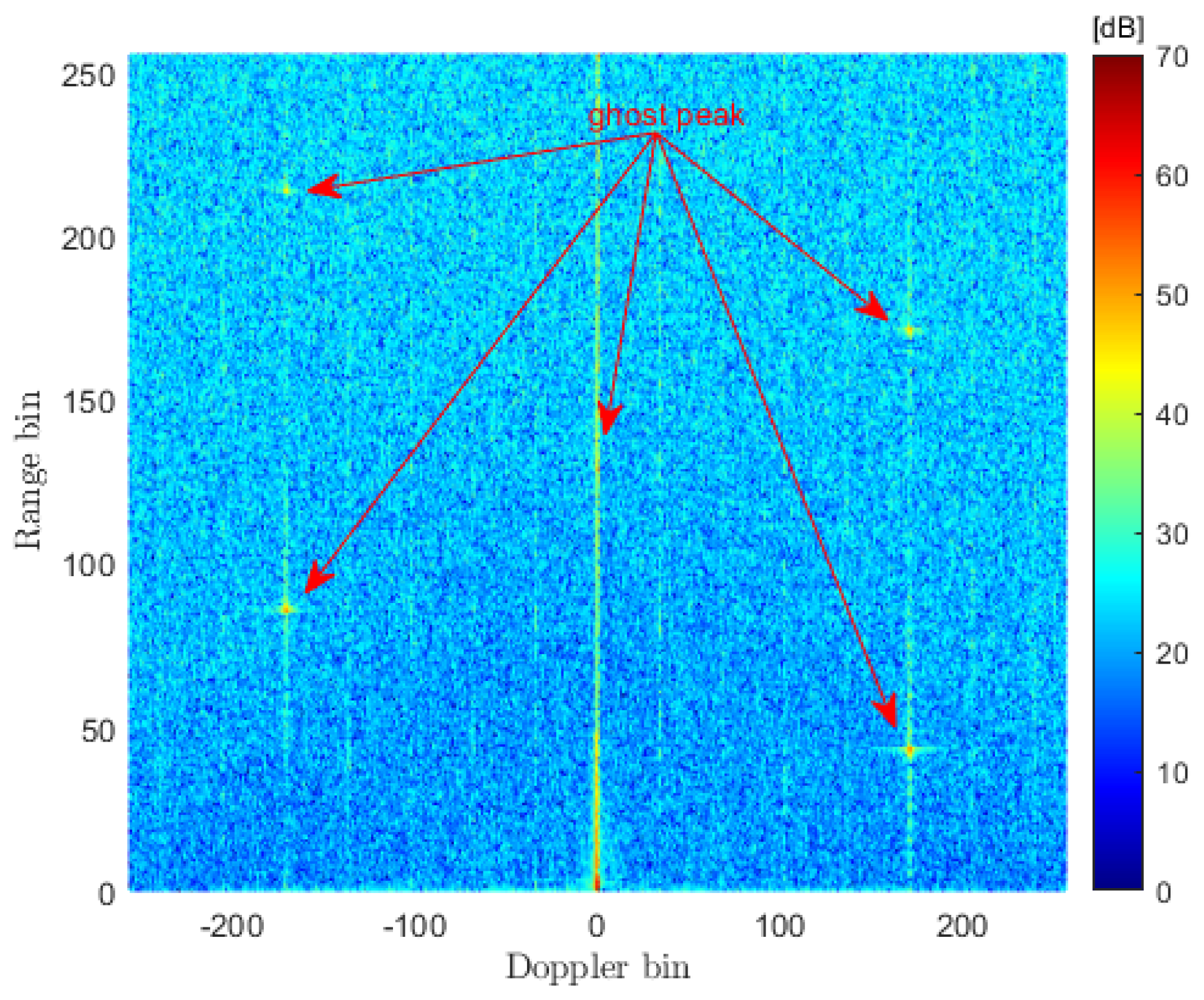
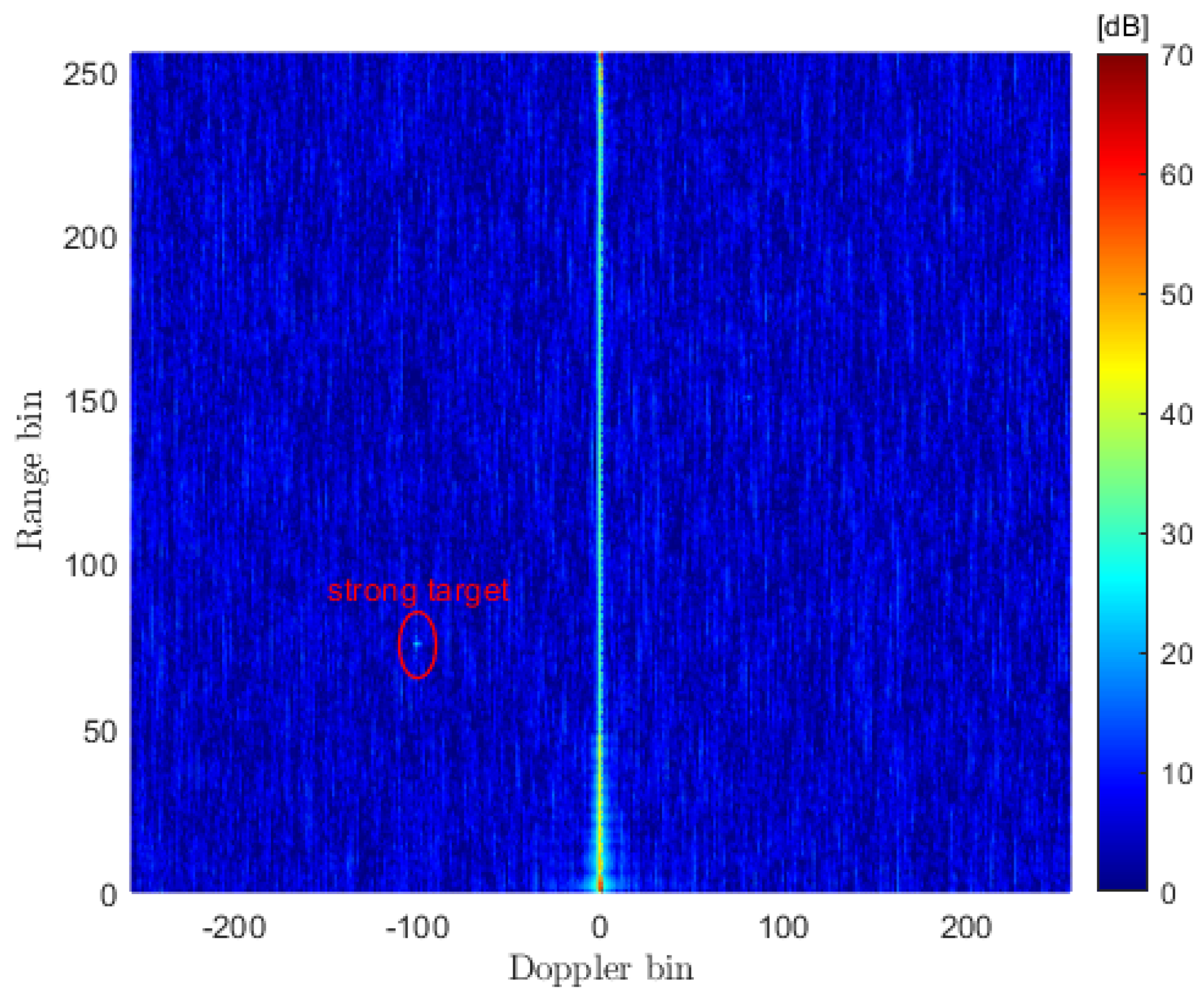

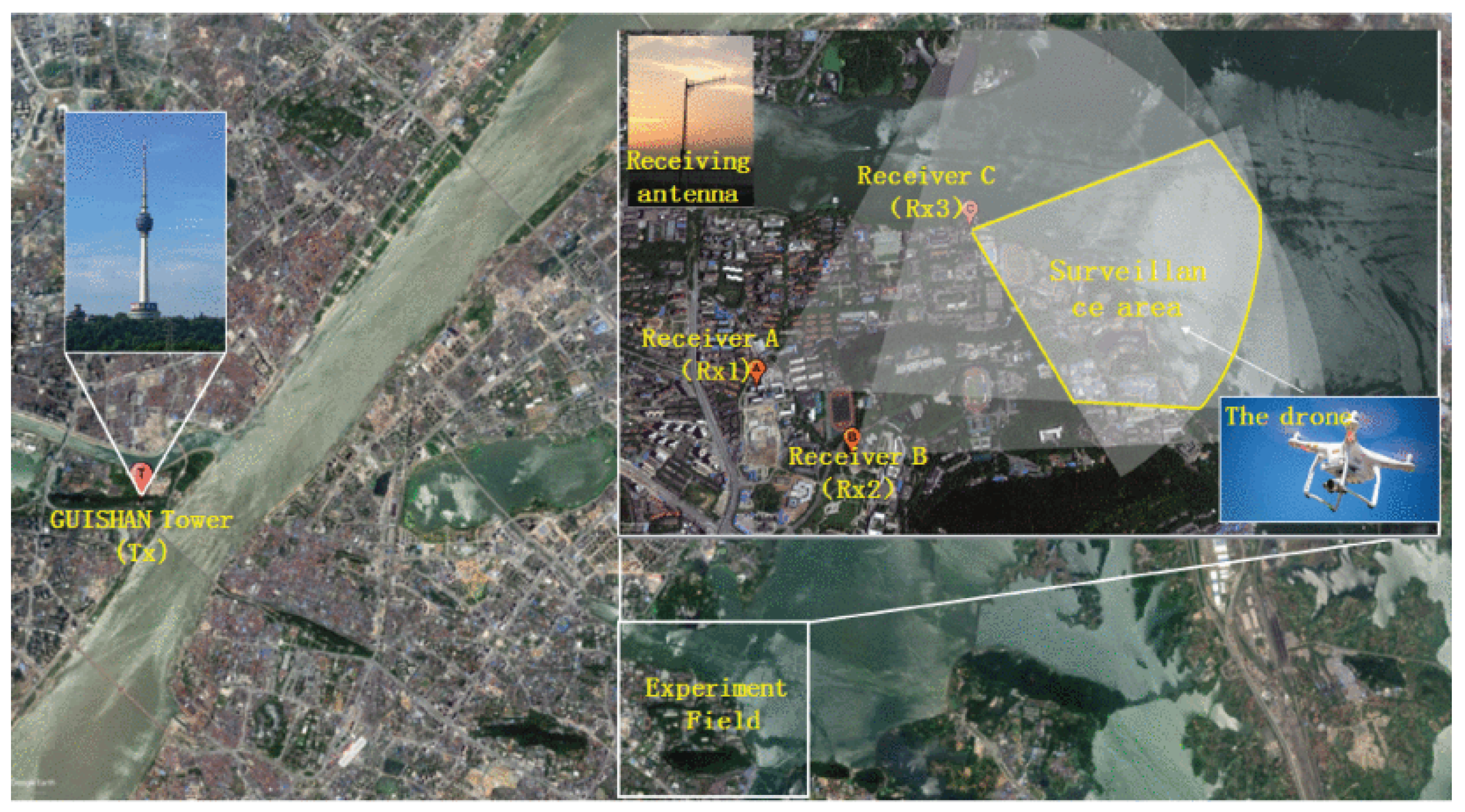

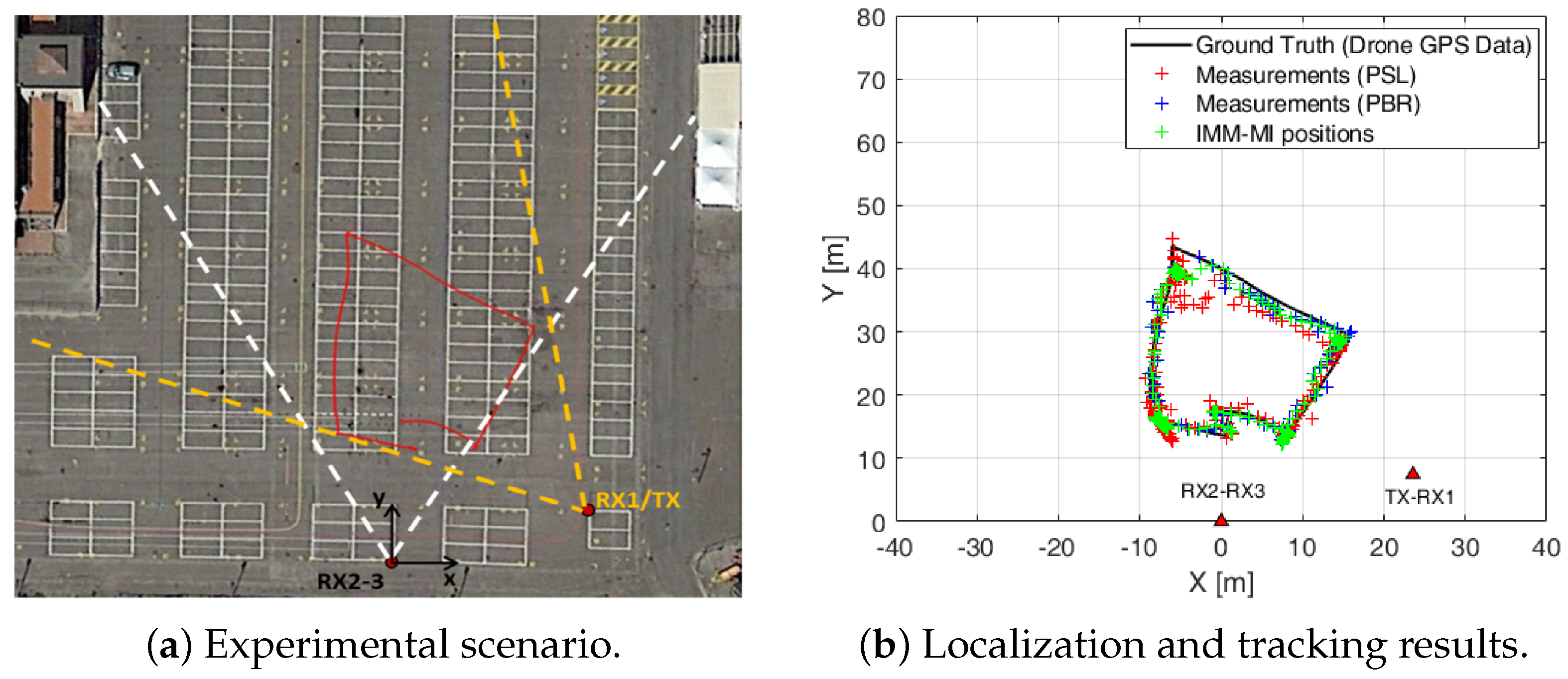
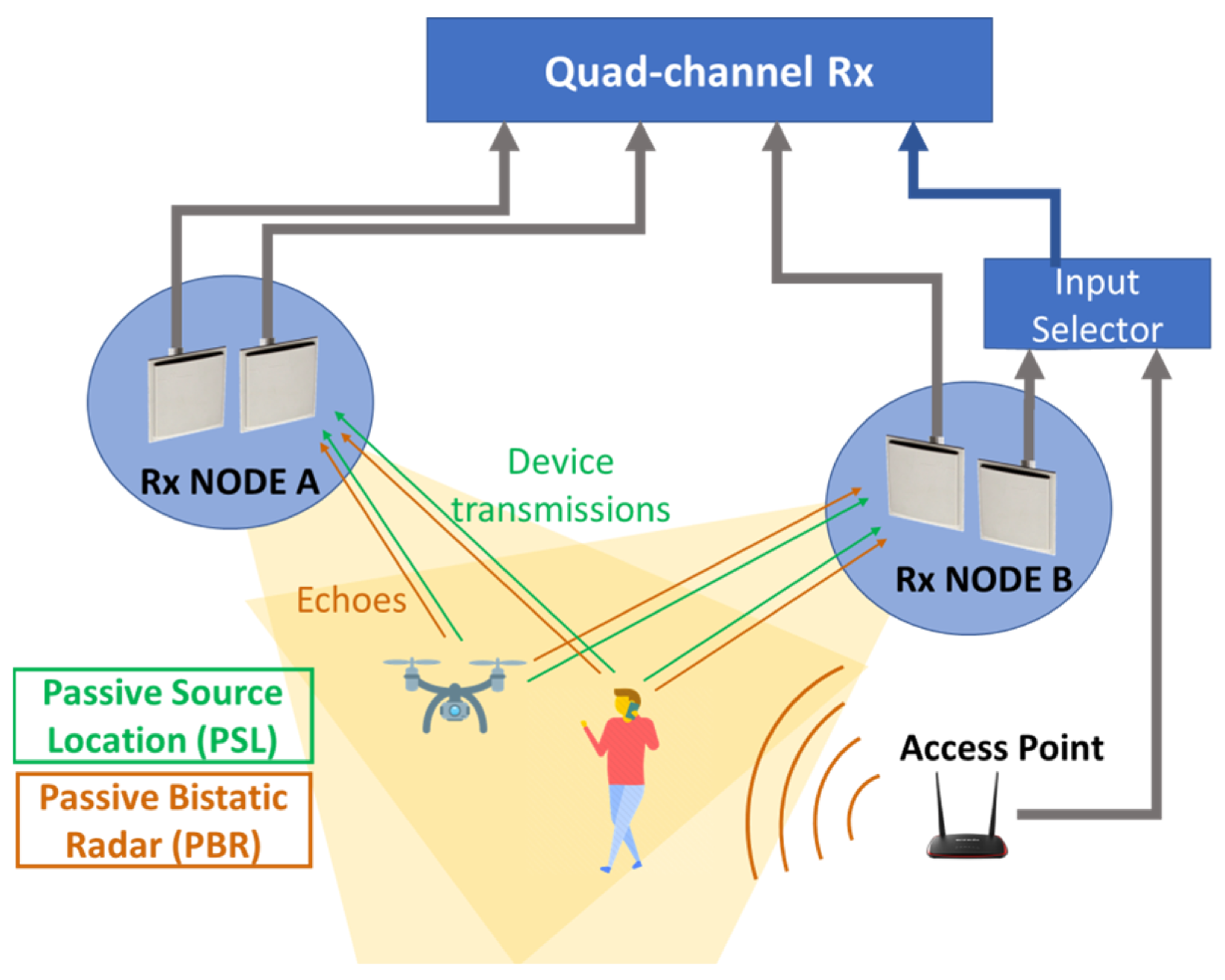
| Signal Type | Category | Description | Frequency Range |
|---|---|---|---|
| LFM | Radar signal | LFM is a radar signal with a linearly varying frequency over time, often used for pulse compression to achieve better range resolution in radar applications. | Depending on the radar system’s design. |
| DRM | Broadcast Radio | A digital radio system for broadcasting on longwave bands. | HF |
| FM Radio | Broadcast Radio | Analog radio broadcasting using frequency modulation. | VHF |
| DAB | Broadcast Radio | A digital radio standard for broadcasting in certain countries, offering clearer sound and more stations. | VHF |
| DVB-T | Broadcast TV | A standard for digital terrestrial television broadcasting. | UHF |
| GNSS | Satellite-Based Positioning | A global navigation satellite system used for positioning, navigation, and timing. | L-band |
| StarLink | Satellite Communication | A LEO satellite network providing global broadband with high speed and low latency. | Ku-band, Ka-band |
| OneWeb | Satellite Communication | A LEO satellite system offering affordable global internet coverage. | Ku-band, Ka-band |
| InmarSat | Satellite Communication | A geostationary satellite network, with new LEO systems for enhanced global communication. | L-band, Ka-band |
| Iridium | Satellite Communication | A LEO satellite network with pole-to-pole coverage, ideal for remote communication. | L-band |
| WiFi | Wireless Communication | A technology for local wireless data transmission. | Industrial, Scientific, and Medical (ISM) Bands (2.4 GHz, 5 GHz, 6 GHz) |
| DVB-S | Satellite TV | A standard for satellite television broadcasting. | C-band, Ku-band |
| 3G | Mobile Communication | Third-generation cellular network technology. | UHF, L-band |
| 4G | Mobile Communication | Fourth-generation cellular network technology, used for high-speed internet. | UHF, L-band |
| 5G | Mobile Communication | Fifth-generation cellular network technology, designed for ultra-fast internet speeds and low latency. | Sub-6 GHz, mmWave |
Disclaimer/Publisher’s Note: The statements, opinions and data contained in all publications are solely those of the individual author(s) and contributor(s) and not of MDPI and/or the editor(s). MDPI and/or the editor(s) disclaim responsibility for any injury to people or property resulting from any ideas, methods, instructions or products referred to in the content. |
© 2025 by the authors. Licensee MDPI, Basel, Switzerland. This article is an open access article distributed under the terms and conditions of the Creative Commons Attribution (CC BY) license (https://creativecommons.org/licenses/by/4.0/).
Share and Cite
Tang, Z.; Ma, H.; Qu, Y.; Mao, X. UAV Detection with Passive Radar: Algorithms, Applications, and Challenges. Drones 2025, 9, 76. https://doi.org/10.3390/drones9010076
Tang Z, Ma H, Qu Y, Mao X. UAV Detection with Passive Radar: Algorithms, Applications, and Challenges. Drones. 2025; 9(1):76. https://doi.org/10.3390/drones9010076
Chicago/Turabian StyleTang, Zhibo, He Ma, Youmin Qu, and Xingpeng Mao. 2025. "UAV Detection with Passive Radar: Algorithms, Applications, and Challenges" Drones 9, no. 1: 76. https://doi.org/10.3390/drones9010076
APA StyleTang, Z., Ma, H., Qu, Y., & Mao, X. (2025). UAV Detection with Passive Radar: Algorithms, Applications, and Challenges. Drones, 9(1), 76. https://doi.org/10.3390/drones9010076






